Tempo in music
In this blog post, you’ll learn everything you need to know about tempo in music. What is tempo, why is it important, and how do you read tempo markings, metronome markings, and other tempo indications in the music so you are playing the piece how the composer intended. Lastly, we will talk about using a metronome to help you practice getting the right tempo.
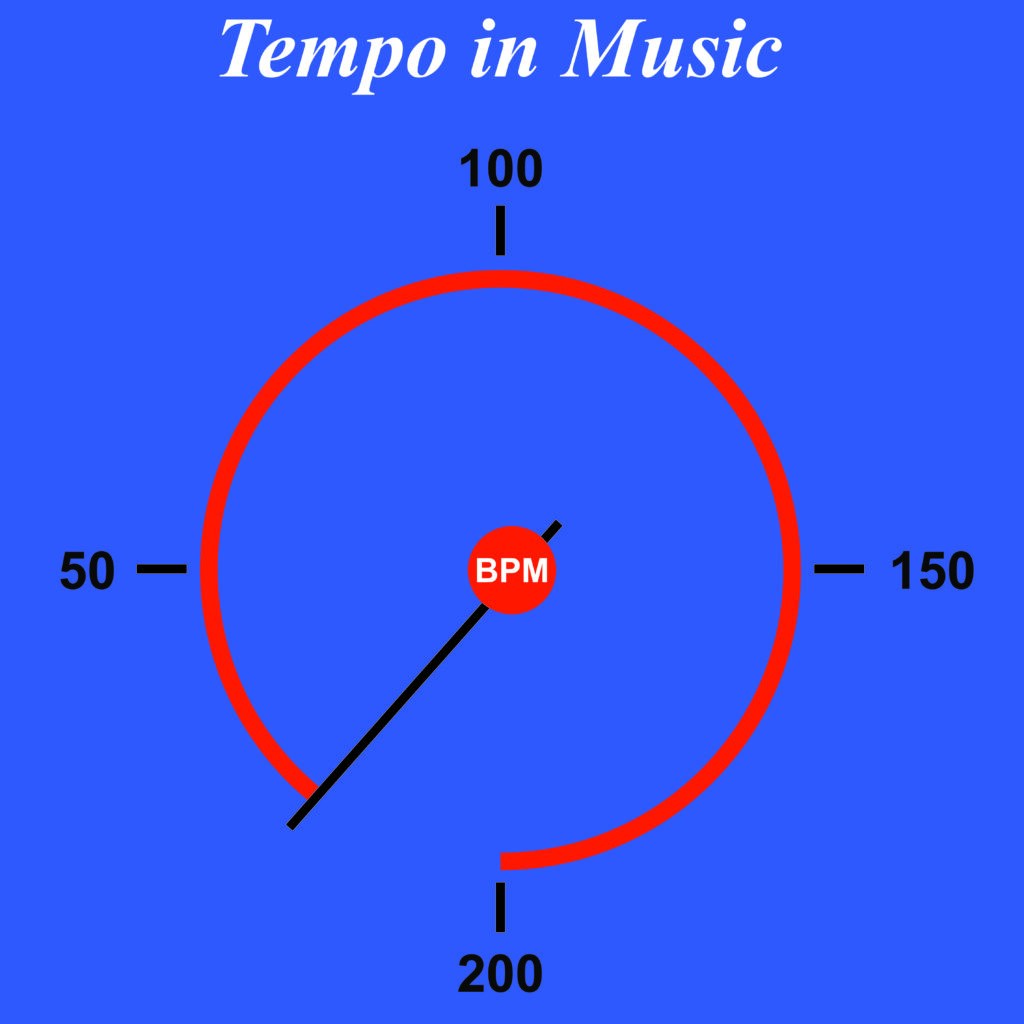
What is tempo in music and why is it important?
Tempo is the speed of the beat of a piece of music. Often, different styles of music use different ranges of tempo. For example, an EDM (electronic dance music) dance track will have a faster tempo than a hip-hop track. And a pop ballad will have a slower tempo than a hip-hop track and most pop songs you’ll hear on the radio. Obviously, not every dance track will be 120 BPM, and not every hip-hop track will be 90 BPM. Each style of music has variations in tempo. Though, each style (or genre) will most likely adhere to a certain range of tempi.
A dance song in the tempo of a pop ballad just won’t sound right! Hence, tempo is a very important aspect of music.
Tempo and metronome markings in the music
In a piece of music, you can easily see what the tempo is via a tempo marking at the beginning of the music just above the staff. Like so many things in music notation, it is often an Italian word. Though, sometimes you will see English words or words in your native language instead.
Tempo is measured in beats per minute (BPM) and every tempo marking has a range of tempi (the Italian plural of tempo) that it fits with. For example, a piece of music with a tempo marking “Moderato” has a tempo range of 80-100 BPM. Now, this is quite a range, and you’ll need to find what tempo fits the piece the best. That could be around 90 BPM, or maybe in the lower or higher end of the range.
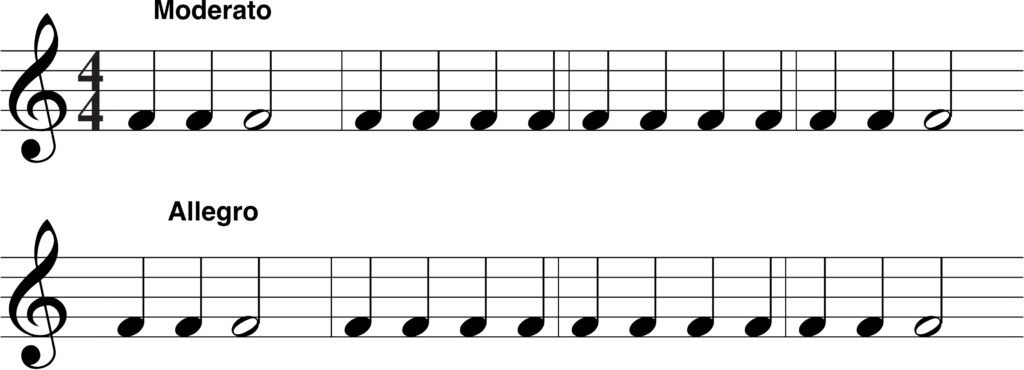
The tempo marking at bar 5 implies you to change the tempo immediately from the initial tempo of the song (Moderato: 80-100 BPM) to a faster tempo (Allegro: 120-156 BPM).
A metronome marking shows the BPM of the piece. So instead of the range of tempi, which is indicated by a tempo marking, a metronome marking will let you know the exact number of beats per minute. Metronome markings are being increasingly used in contemporary sheet music. I find this a good thing as the range of tempi with some of those tempo markings can be too big to really help the performer finding the right tempo. You will also encounter the BPM, or the metronome marking, indicated along with the Italian (or other language) tempo marking. This, however, is misleading. For example, a metronome may have allegro marked at 120 beats per minute and andante marked at 80 beats per minute. Allegro should certainly be quite a bit faster than andante, but it may not be exactly 120 beats per minute. A tempo marking that is a word or phrase gives you the composer’s idea of how fast the music should feel.
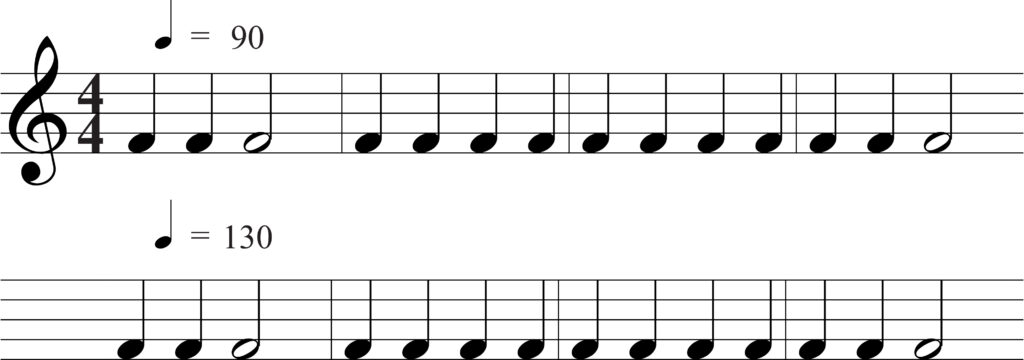
In 4/4 time, the quarter note gets the beat. So in this case, there’ll be 90 beats, or 90 quarter note beats, per minute. This will change in measure 5 from where the speed of the tempo changes to 130 quarter note beats per minute.
So you will always find a tempo indication at the beginning of a piece of music. Otherwise, you wouldn’t know how fast to play the song.
If you’re not playing a piece of music in the correct tempo, the song won’t sound like you expect it to or how the composer imagined it. Therefore, it is very important to play the piece at the correct tempo. Obviously, you can practice it at a lower tempo.
Here is a list of the 5 most common Italian tempo markings along with their BPM range:
- Adagio: Slow (60-70 BPM)
- Andante: At a walking pace (70-80 BPM)
- Moderato: Medium speed (80-100 BPM)
- Allegro: Fast (120-156 BPM)
- Presto: Very fast (168-200 BPM)
Tempo changes
There are two kinds of changes in tempo. Changes in tempo can be a sudden change in tempo, or a gradual change in tempo. Again, we use Italian words or terms to indicate this in the music.
We’ve already encountered sudden changes in tempo. Hence, the initial tempo of the piece will always be indicated at the beginning, and then later if any tempo changes are required it will be indicated with a new tempo (or metronome) marking above the staff.
A sudden change in tempo using tempo markings: If the composer wants a sudden change in tempo, where you’ll have to change the tempo immediately, they’ll simply write a new tempo. For example, in this song Moderato is marked at the beginning of the piece, but at the top of measure 5 there’s a new tempo marking Allegro. This means that you’ll play the first 4 measures of the song using Moderato, and then when you get to measure 5 in the next line, you’ll change the tempo to Allegro and play the next 4 bars a little faster. Using tempo markings, we’ve got this range of tempi, but no matter what you’ll immediately have to increase the speed of your playing at a certain degree within the 2 ranges of tempi that are indicated with tempo markings above the music.

A sudden change in music using metronome markings: A sudden change in tempo can also be indicated by a metronome marking showing you the new tempo in beats per minute (BPM). I.e. a metronome marking will give you the exact tempo. Not just a range of tempi as is the case with tempo markings. Here’s the same excerpt of a song using metronome markings instead:
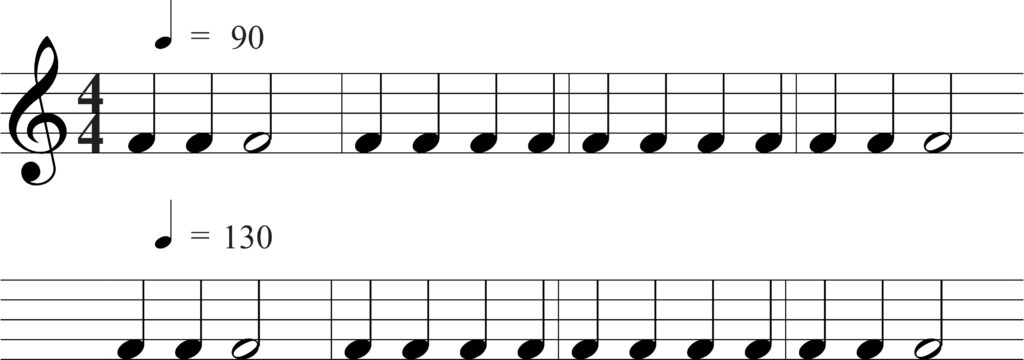
A sudden change in tempo means that we change the tempo straight away. No matter if it’s indicated by tempo markings or metronome markings.
A gradual change in tempo: A gradual change in tempo implies that you’ll gradually speed up or slow down to a new tempo. Usually within one or a few bars.
Again, to indicate this, there are some Italian words in common use:
– Accelerando (abbreviation: accel.) = speed up
– Rallentando (abbreviation: rall.) or Ritardando (abbreviation: rit.) = slow down
Often, you’ll see these gradual changes in tempo marked using the abbreviations accel., rall., and rit.
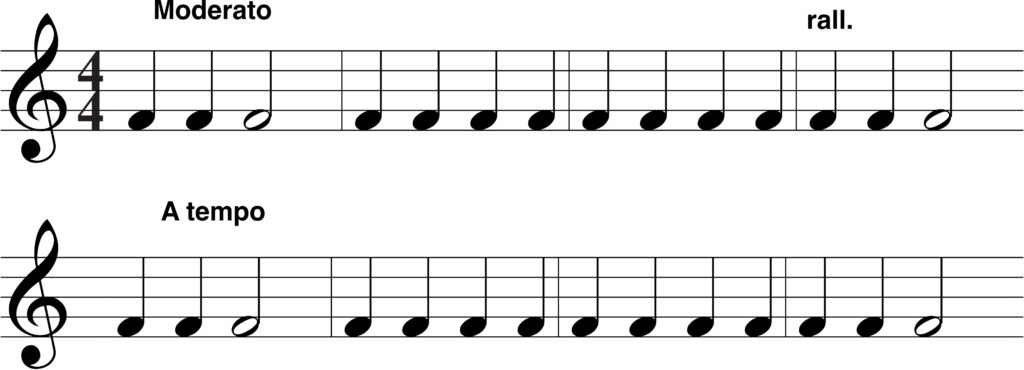
In this excerpt of a song, there’s a Rallentando (abbreviated rall.) in measure 4.
So when we get to measure 4, we will need to gradually slow down till the end of measure 4.
In measure 5 there’s the tempo marking “A tempo”, which means that we shall be going back to the initial tempo of the song (Moderato) that’s marked at the beginning of the piece.
– A tempo = return to original tempo
Sudden and gradual changes in tempo give variation and expression to the music.
Using a metronome
A metronome will help you practice getting the right tempo. It can be set to 1 click (beat) = any BPM count. For example, if Andante is marked at the top of the piece of music, you know that this tempo indication means that you’ll play the tune at 70-80 BPM. Then you can set the metronome to somewhere between 70-80 BPM to play the piece at the right tempo.
BPM (Beats Per Minute) is the number of beats per minute. So if you want each beat to last for 1 second, you’ll set the metronome to 60 BPM. Now 1 beat equals 1 second, and the tempo you’ll play at is 60 BPM.
You can buy an old-fashioned metronome online or at a music store. You can also download a free metronome app on your phone or iPad, such as the Metronome Beats app. Every DAW (Digital Audio Workstation) like Logic Pro, Cubase, Studio One etc., will have a metronome. This will be able to play beat divisions as well.
If you are using an app, you may be able to indicate the time signature you are practicing with as well, by setting the clicks to four, three, or two beats per measure. This way, the first beat of each measure will sound a little different than the others, which makes it easier to feel the beat and play along songs in different time signatures. Certain physical metronomes can do this as well.
Outro
Now you know what tempo in music is and how to navigate a piece of music with some of the most common tempo indications you’ll encounter. Thereby, you know when to instantly or gradually change the tempo while playing a song. You also know how to practice playing at the correct tempo using a metronome. I hope you have a lot of fun practicing your instrument. If you encounter a tempo marking that you don’t know, just look it up in a music dictionary or do a Google search.
If you found this blog post valuable, you can share it below.
SHARE POST
